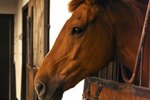Angry horses can quickly become aggressive and dangerous. They may attempt to bite, strike or kick, causing serious injuries. Learn to recognize the signs of anger and aggression so you can handle the situation before anyone is injured.
You may be able to calm an angry horse by redirecting his attention. If you know what is making him angry, such as another horse, removing him from the area may diffuse his anger.
Warnings
If your horse becomes unsafe due to aggression towards humans, consult a professional trainer or animal behaviorist to work with your horse.
Head and Ears
When a horse is angry, he pins his ears back to his neck. He may have his ears turned back, but not fully pinned. While this could be a signal he is listening to something behind him, if turned back ears are accompanied by tension in his body or a swishing tail, this also could indicate anger.
An angry horse's muzzle will tighten and he will purse his lips. This also may indicate stress or fear. When preparing to bite, he may gape his mouth so his teeth are visible.
The skin around his eyes will tighten and the whites of his eyes may be showing.
Finally, a horse who is feeling aggressively angry may lower his head slightly and move it from side to side in a snaking motion.
Body Language
A horses who is irritated may stomp his feet. Pawing with the front legs usually indicates boredom or stress, but some horses will do this when angry. His hind leg may be cocked or raised to indicate irritation or that he may be preparing to become aggressive and kick. If anger escalates, he may strike out aggressively with his foreleg or kick with his hind legs.
An angry horse swishes his tail rapidly. He may be preparing to buck or kick. He also may swing his entire hindquarters from side to side.
Warnings
If your horse is showing signs that he is angry and getting ready to kick, bite or strike, move away and give him enough space so that you are not injured.
Writer Bio
Maureen Malone started writing in 2008. She writes articles for business promotion and informational articles on various websites. Malone has a Bachelor of Science in technical management with an emphasis in biology from DeVry University.





